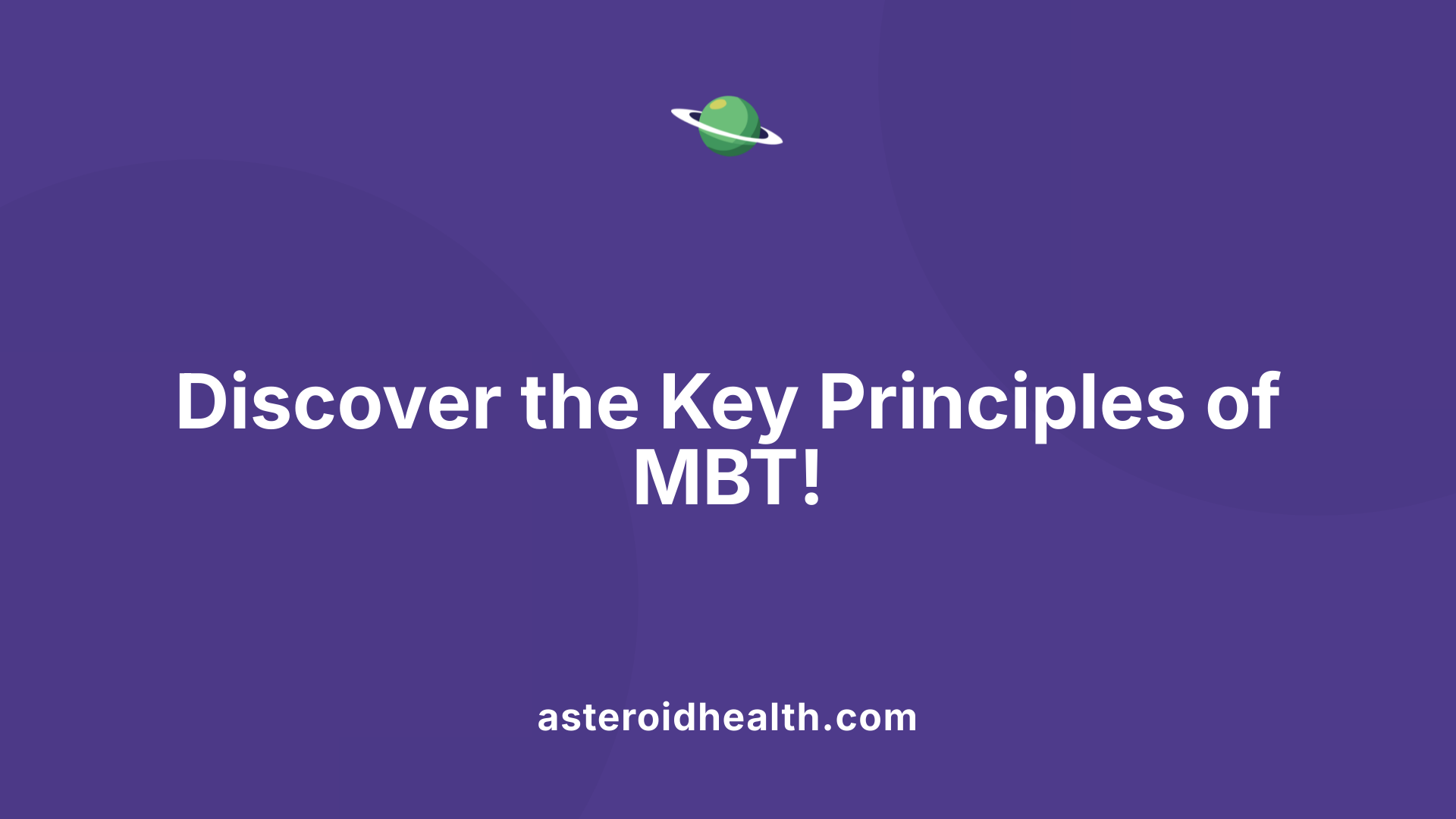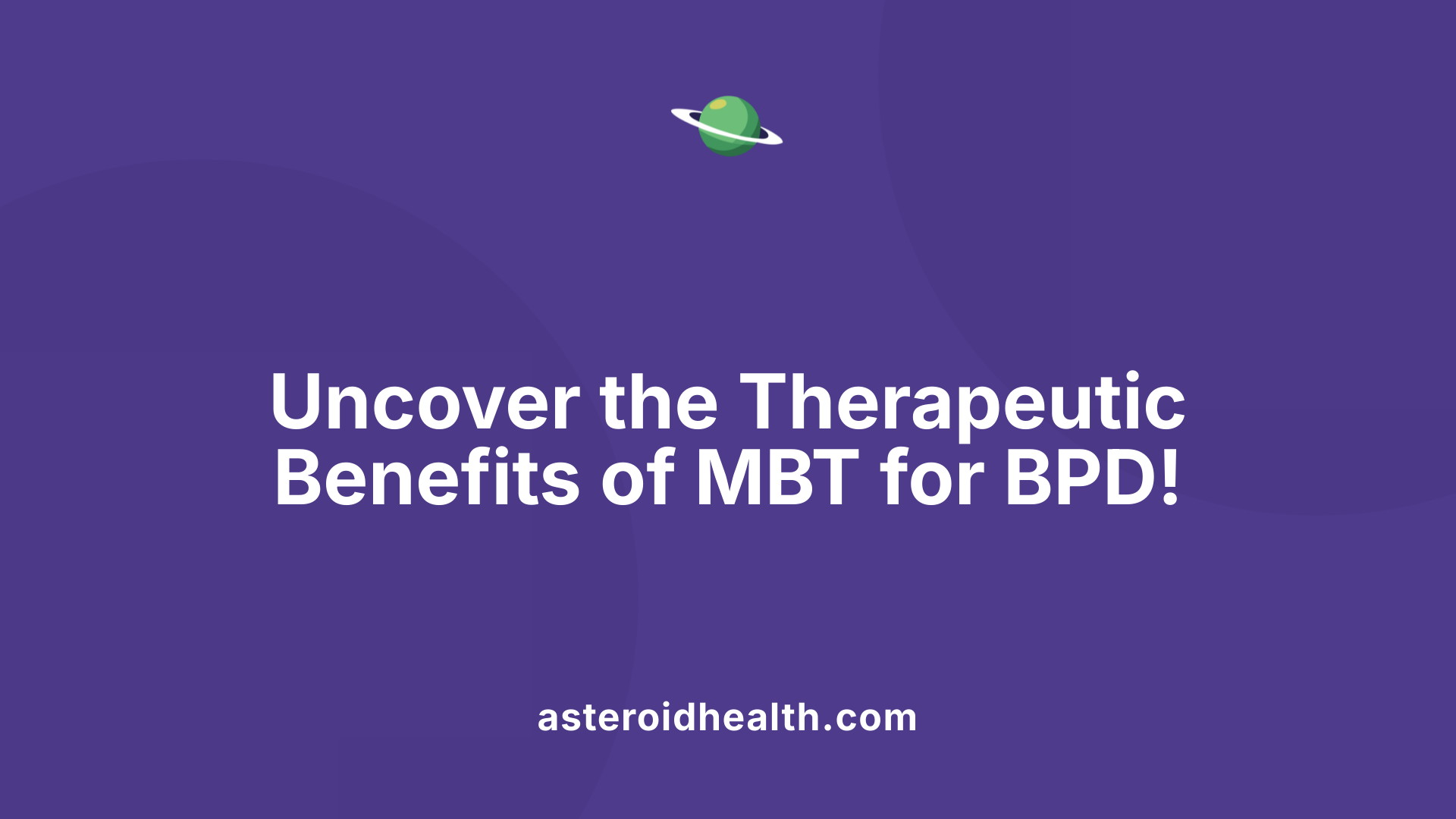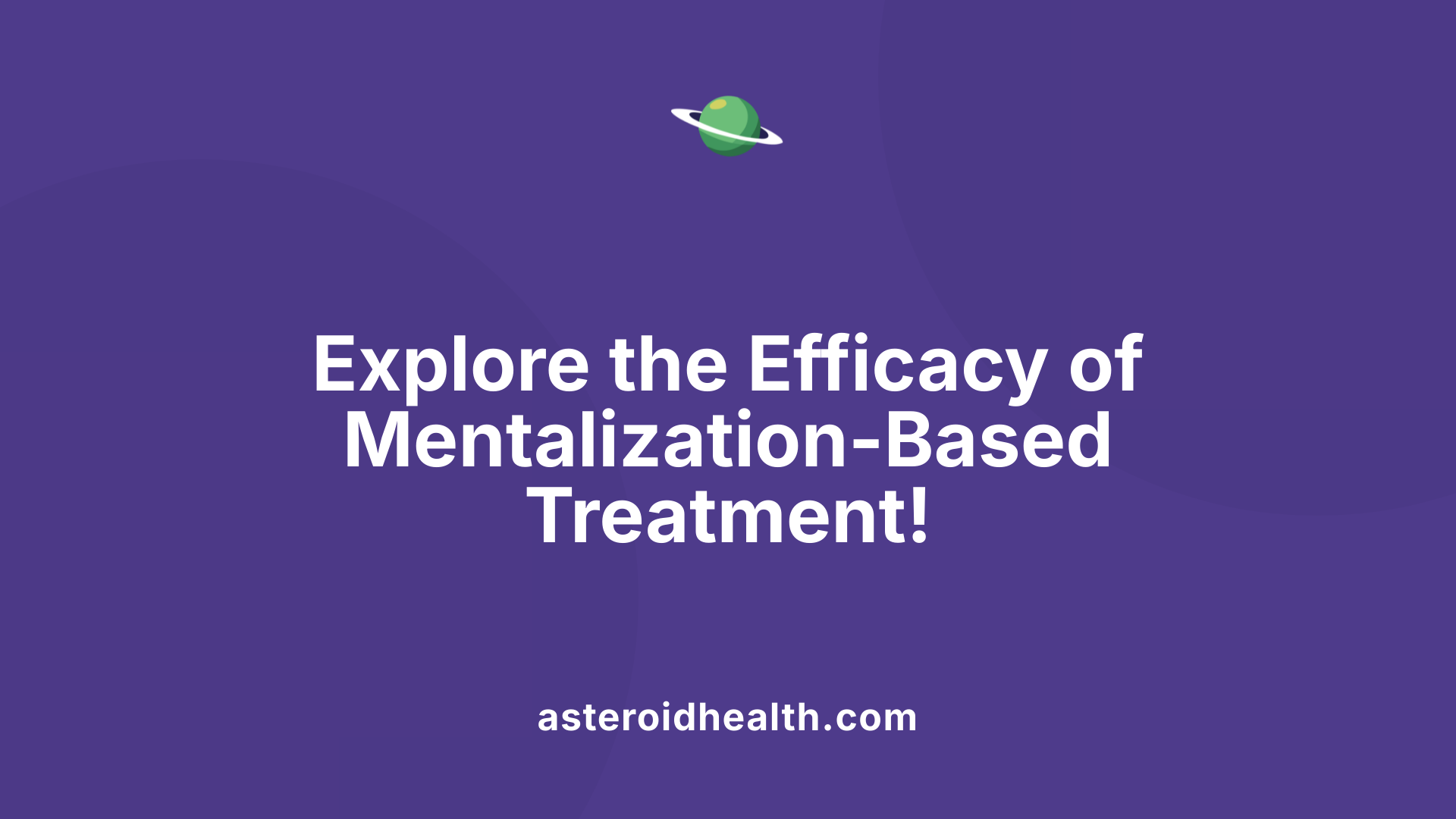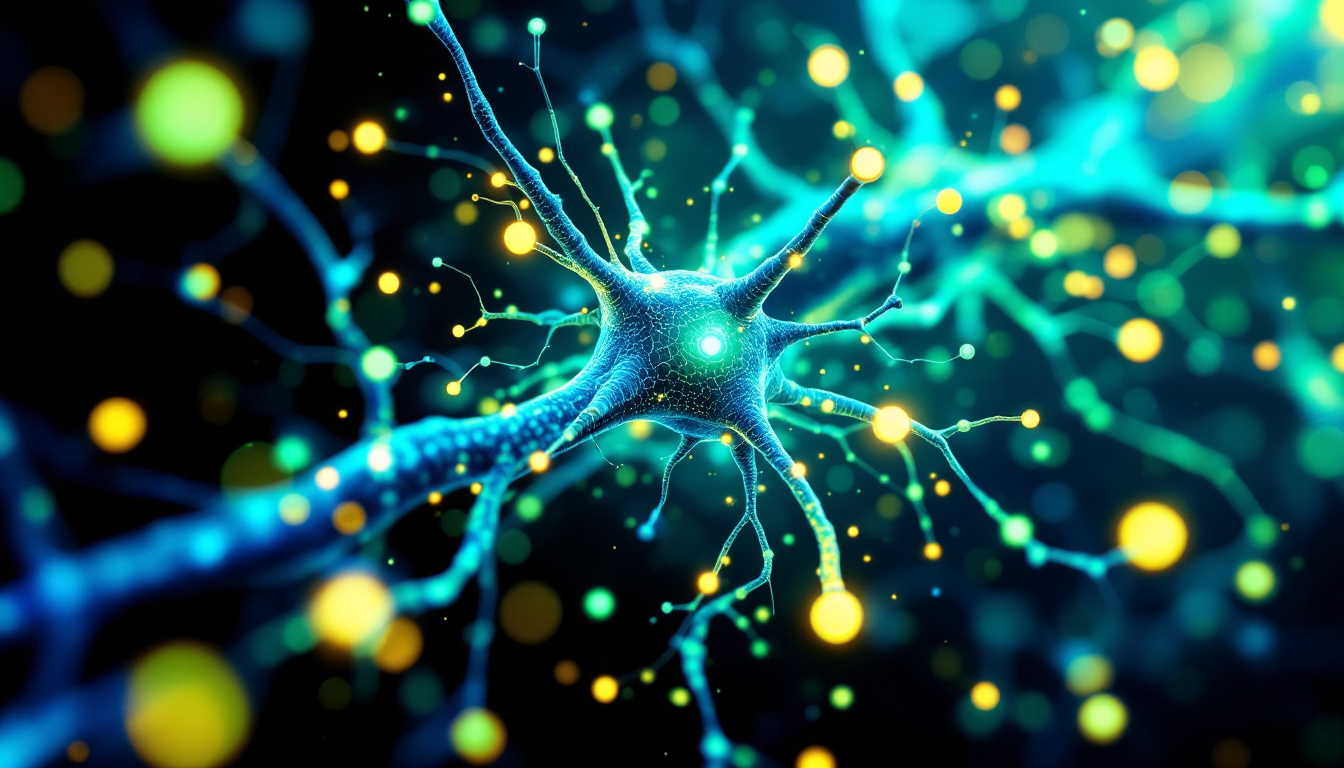Mentalization-Based Treatment for Personality Disorders
Exploring the Therapeutic Scope of Mentalization-Based Treatment

Understanding the Basics of MBT
Mentalization-Based Treatment (MBT) is gaining recognition for its focused approach in treating personality disorders, especially Borderline Personality Disorder (BPD). By improving the ability to mentalize, MBT aids individuals in understanding their own and others' mental states, establishing a foundation for better emotional regulation and interpersonal relationships.
Core Principles of Mentalization-Based Treatment

What is Mentalization-Based Treatment (MBT) and what are its key principles?
Mentalization-Based Treatment (MBT) is a specialized form of psychotherapy designed primarily for individuals with borderline personality disorder (BPD) but has shown efficacy in treating other personality disorders. Its foundational premise rests on enhancing the individual’s capacity to understand both their own mental states and those of others. This ability, referred to as mentalization, is crucial for effective emotional regulation and maintaining healthy interpersonal relationships.
The therapy operates on several key principles:
- Understanding Mental States: At the heart of MBT is the focus on recognizing and interpreting one’s own thoughts, feelings, wishes, and desires, along with those of others.
- Present Focus: Unlike many therapeutic approaches that delve into past experiences, MBT prioritizes current interactions. This real-time exploration helps patients better navigate their emotions and responses in everyday life.
- Structured Approach: MBT is delivered in structured sessions that include both individual and group formats, promoting shared learning and emotional understanding among participants.
- Collaborative Goal Setting: The initial phase involves assessing mentalizing capabilities to collaboratively set treatment goals, ensuring that the therapy is tailored to the patient's unique needs.
Mechanisms of improvement
Research has shown that MBT can lead to significant improvements in psychiatric symptoms, interpersonal skills, and overall well-being. The mechanisms for this improvement primarily center around the enhancement of mentalizing capacity.
- Reflective Functioning: As patients improve their ability to reflect on their mental states, they often experience better emotional regulation, leading to decreased feelings of distress and impulsivity.
- Sustained Gains: Long-term studies indicate that many who undergo MBT continue to benefit from its teachings, experiencing maintained improvements in social functioning and reductions in harmful behaviors.
In summary, MBT stands out as an effective treatment for BPD, integrating modern psychological theories with practical therapeutic interventions to assist patients in building more fulfilling relationships and healthier emotional responses.
The Therapeutic Value of MBT for Borderline Personality Disorder

How does MBT specifically help individuals with borderline personality disorder (BPD)?
Mentalization-Based Treatment (MBT) provides targeted support for individuals with borderline personality disorder (BPD) by improving their ability to mentalize, which means understanding their own and others' emotional and psychological states. This skill is crucial for emotional regulation and forming healthy interpersonal relationships.
Research has shown that patients undergoing MBT experience significant reductions in BPD symptoms, which include intense emotional instability, impulsive behaviors, and difficulties in relationships. Improvements are evident in various areas:
- Decrease in Emotional Dysregulation: Patients learn to manage their emotions better, leading to less chaotic responses to stressors.
- Reduction in Self-Harm: MBT has been associated with decreased instances of self-harming behaviors and fewer suicide attempts, critically addressing the safety concerns inherent in BPD.
- Enhanced Life Quality: Patients report improved overall functioning, reflected in higher Global Assessment of Functioning (GAF) scores, indicating strides in day-to-day life satisfaction.
Moreover, MBT maintains positive impacts even after the treatment ends, with long-term studies pointing to sustained improvements in both mental health and social functioning.
How does MBT enhance mentalizing capacity?
The structured nature of MBT focuses on cultivating mentalizing skills over the course of therapy. Through both individual and group sessions, patients practice reflective interactions that enhance their understanding of their own and others' thoughts and feelings. As they engage in therapy, patients learn to:
- Recognize their emotional triggers and responses in real-time.
- Understand the perspectives and intentions of others, which can alleviate misunderstandings in relationships.
Research has documented significant advancements in mentalizing capacity among patients, with studies indicating medium to large effect sizes in improvement over time. This growth is essential, given that BPD is characterized by reduced mentalizing abilities, leading to challenges in emotional regulation and impulse control.
In summary, Mentalization-Based Treatment effectively reduces core symptoms of BPD while enhancing patients’ mentalizing capabilities, proving it to be a powerful therapeutic approach.
Evaluating the Efficacy of MBT

What research has been conducted on the effectiveness of MBT for personality disorders?
Research on Mentalization-Based Treatment (MBT) has produced encouraging outcomes, particularly for individuals with borderline personality disorder (BPD). A systematic review encompassing fourteen studies highlighted MBT's effectiveness in significantly reducing symptom severity and enhancing overall quality of life.
| Study Details | Findings | Effect Sizes |
|---|---|---|
| Systematic review of 14 studies | Reduced BPD symptom severity, decreased self-harm, and lower suicide attempts | 0.59 to 1.79 |
| Focus on comorbid disorders | Improved global functioning, reduced reliance on medications | [More info needed] |
Overall, patients receiving MBT not only reported lower levels of depression and anxiety but also exhibited enhanced functioning in social and occupational realms. Specific interventions within MBT, such as demand questions and empathic validation, appear to drive these positive outcomes.
Furthermore, evidence suggests that MBT's benefits extend beyond BPD, indicating its potential efficacy across a range of personality disorders. While most of the focus has been on BPD patients, studies have shown significant improvements in mentalizing capabilities, which could translate to broader applications in treating other disorders displaying similar impairments.
These findings signal a growing interest in the therapeutic approach of MBT, highlighting its role in transforming mental health outcomes for a diverse patient population.
The Evolution and Relevance of Mentalization Theory

How was the theory of mentalization developed and how is it relevant in therapy?
The theory of mentalization emerged from a rich background of psychoanalytic and attachment theories, aiming to explain how individuals understand their own and others' mental states. Mentalization revolves around perceiving behaviors as expressions of intentions, needs, and beliefs.
Research has linked the development of mentalizing abilities to early attachment experiences. Secure attachments foster the social intelligence and emotional regulation necessary for effective mentalization. Conversely, disruptions during formative years, such as maltreatment or caregiver loss, can impair the capacity to mentalize, leading to emotional dysregulation often observed in individuals with Borderline Personality Disorder (BPD).
Mentalization is critical for emotional functioning and the development of healthy interpersonal relationships. When patients learn to better recognize their thoughts and feelings in the context of their interactions, they gain deeper self-understanding and empathy. This can be transformative, particularly for those who struggle with intense emotions and impulsive behaviors.
In therapeutic settings, techniques derived from Mentalization-Based Treatment (MBT) focus on enhancing these skills. By engaging in both individual and group therapy sessions, patients practice reflecting on their internal experiences and those of others. This approach ultimately aids clients in navigating emotions and improving their interpersonal dynamics.
The development of mentalization theory has thus provided a robust framework that informs not only treatment for BPD but also offers insights applicable to various psychological disorders. By fostering better mentalizing capabilities, clinicians can promote significant improvements in emotional regulation and relationship management, enhancing the overall psychological well-being of their clients.
Navigating the MBT Therapeutic Process

What should a patient expect during the MBT therapeutic process?
During the Mentalization-Based Treatment (MBT) therapeutic process, patients can expect engaging in structured sessions designed to enhance their mentalization skills. This journey begins with an evaluation phase where therapists assess each patient's specific mentalizing vulnerabilities.
Typically lasting between 12 to 18 months, sessions focus on the patients' current experiences and emotional responses. The therapists employ techniques that encourage self-reflection and aim to stabilize emotions. Key components of these sessions include discussions that touch on personal relationships and behaviors, a process that is essential for applying mentalization strategies to improve interpersonal dynamics.
Throughout therapy, the therapist plays a crucial role in creating a supportive atmosphere characterized by empathy and curiosity. They guide patients in overcoming challenges associated with reflective thinking and emotional exploration, facilitating a deeper understanding of their own and others' mental states.
Structure of the treatment
The structure of MBT is carefully organized to foster effective learning and growth. Initially, the therapy comprises a comprehensive assessment where clients collaborate with therapists to identify problems and set treatment goals based on their mentalization capacities. The approach is both time-limited and goal-oriented, focusing primarily on enhancing the ability to recognize and interpret emotional and mental states.
The treatment itself is designed to be flexible, consisting of both individual and group therapy sessions. This dual approach allows for diverse interactions, helping patients practice mentalization in various contexts. The blend of personal reflection and group dynamics significantly contributes to improving patients' emotional regulation and interpersonal relationships. Overall, MBT stands out due to its structured yet adaptable process, making it accessible and effective for patients recovering from borderline personality disorder.
Comparing MBT to Other Therapeutic Approaches
How does MBT compare to other treatment options for personality disorders?
Mentalization-Based Treatment (MBT) has emerged as an effective method for managing borderline personality disorder (BPD), particularly through enhancing mentalization abilities. This process allows patients to better comprehend their own thoughts and feelings, alongside those of others. While existing studies demonstrate that MBT produces borderline significant benefits over standard treatment approaches, it has not been established as the definitive best practice for reducing suicidal behaviors.
A prominent alternative is Dialectical Behavior Therapy (DBT), which is frequently recommended as a primary treatment for BPD. DBT is particularly effective due to its focus on emotional regulation and behavioral transformation, making it a complementary approach alongside MBT. Both therapies significantly address crucial issues such as self-harm and emotional dysregulation, often applied in concert to achieve comprehensive therapeutic gains.
Strengths and limitations
While MBT offers a structured timeframe for treatment with a focus on interpersonal relationships, its comparative long-term efficacy against therapies like DBT and Cognitive Behavioral Therapy (CBT) still requires thorough investigation. Research indicates that MBT supports improvements in mentalizing capacity and decreases in psychiatric symptoms, particularly in BPD patients, but the landscape of personality disorder treatment remains complex.
In summary, while MBT is validated for BPD treatment, more robust research is necessary to elucidate its effectiveness across a broader spectrum of personality disorders and to fully compare it with other therapeutic modalities such as DBT and CBT.
| Therapy Type | Focus | Strengths | Limitations |
|---|---|---|---|
| Mentalization-Based Treatment (MBT) | Enhancing mentalization | Effective for BPD, accessible for clinicians | Research on long-term effects needed |
| Dialectical Behavior Therapy (DBT) | Emotional regulation | First-line treatment, comprehensive focus | Requires extensive training for therapists |
| Cognitive Behavioral Therapy (CBT) | Thought and behavior change | Widely applicable, structured approach | May not directly address emotional dysregulation |
Lesson from Pioneers: Anthony Bateman and Peter Fonagy
Contributions to MBT Development
Anthony Bateman and Peter Fonagy are credited with the development of Mentalization-Based Treatment (MBT), a therapeutic approach designed specifically for individuals with Borderline Personality Disorder (BPD). Their landmark work synthesized traditional psychoanalytic concepts with modern insights from attachment theory and social cognition. This integration created a structured treatment methodology that addresses the unique challenges faced by those with BPD, particularly difficulties in understanding their own and others' mental states.
Foundational Theories
Bateman and Fonagy posited that disruptions in childhood relationships significantly impact individuals’ mentalizing abilities later in life. They highlighted that the insufficient development of mentalization during early experiences—often stemming from caregiver loss or maltreatment—can lead to an increased risk of developing BPD. By focusing on enhancing these mentalization skills, MBT aims to improve emotional regulation and interpersonal effectiveness in patients, paving the way for better social functioning and quality of life.
Expanding Horizons: The Adaptability of MBT
MBT for Different Age Groups
Mentalization-Based Treatment (MBT) isn’t just for adults; it has been adapted for younger patients through the creation of MBT-A (Mentalization-Based Treatment for Adolescents). This tailored approach recognizes that the developmental needs of adolescents differ from those of adults, offering a structure that supports youth in improving their mentalizing abilities. The adaptation is crucial as adolescent patients often face unique challenges in their emotional and social development.
Applications Beyond BPD
MBT originally targeted Borderline Personality Disorder (BPD), but research reveals its positive effects extend to various other psychological disorders. Studies have shown MBT effective for patients with antisocial personality disorder, eating disorders, and even PTSD. This versatility comes from its central focus on enhancing mentalizing capacity—an essential skill that benefits various patient populations. The therapy's core principles of understanding one's own and others' mental states make it a promising modality across diverse treatment contexts.
Accessibility and Training Ease of MBT for Practitioners
Ease of learning MBT
Mentalization-Based Treatment (MBT) has garnered attention not only for its effectiveness but also for its accessibility to mental health professionals. The training required to implement MBT is relatively brief, making it easier for therapists to acquire the necessary skills. This training focuses on fundamental concepts of mentalization and therapeutic techniques that enhance a practitioner's ability to help clients with Borderline Personality Disorder (BPD).
Increase in MBT providers
The streamlined learning process of MBT allows a growing number of providers to offer this treatment. As more clinicians become trained in MBT, the availability of effective treatment for BPD increases, ultimately benefiting patients who need this specialized support. This expansion reflects a growing recognition of mentalization as a crucial component in addressing the emotional and relational difficulties faced by individuals with BPD.
MBT Research: Current Trends and Future Directions
Ongoing Research and Trials
Recent studies on Mentalization-Based Treatment (MBT) have significantly expanded our understanding of its effectiveness. Since 2015, 14 new trials have highlighted its role not only in treating borderline personality disorder (BPD) but also its potential benefits for a wider range of personality disorders and psychological conditions. Findings indicate observable improvements in patients' mentalizing capacities, alongside significant reductions in psychiatric symptoms and enhanced social functioning.
Need for Further Studies
Despite these promising outcomes, research on MBT still calls for methodologically sound studies with adequate participant sizes. Many current studies focus primarily on adult populations, suggesting a gap in understanding MBT’s long-term effects and applicability in different demographics, such as adolescents or other personality disorders. The ongoing research aims to clarify these aspects, reinforcing the need for continuous evaluation and adaptation of MBT in clinical practices.
Summary and Future Directions
Mentalization-Based Treatment continues to evolve, offering significant improvements for those with personality disorders, especially BPD. Through enhancing mentalizing capacity, MBT provides patients with the skills to better manage their emotions and interactions. However, as research progresses, it becomes evident that more studies are needed to understand its broad applicability and potential benefits for other disorders. The promising developments in MBT pave the way for more effective and inclusive mental health treatments.
References
- A Guide to Mentalization-Based Treatment for BPD
- Mentalization based treatment for borderline personality ...
- Mentalization-Based Treatment: A Common-Sense ...
- Mentalization Based Therapy for BPD
- Mentalization-Based Treatment for Personality Disorders
- Mentalization based treatment for a broad range of personality ...
- Mentalization-based treatment for personality disorders
- The five tenets of family-based treatment for adolescent eating ...
Recent articles

Understanding Schizophrenia: Symptoms and Subtypes

The Role of Pets in Supporting Mental Health

How to Develop a Positive Body Image

Psychosocial Interventions for Schizophrenia

The Impact of Grief on Mental Health

How to Set Boundaries for Mental Health

Addressing Body Dysmorphia Without Obsession

High-Functioning Depression: When Depression Is Hidden

OCD Recovery and Staying Resilient Against Triggers

Natural Remedies for Managing Anxiety

Mindfulness Meditation to Reduce OCD Triggers

How Social Media Affects Mental Health

Personality Disorders and Identity Issues

Exercise As a Tool for Mood Enhancement

How a General Outpatient Program Supports Long-Term Recovery

Excoriation Disorder: Why Skin Picking Happens

The Role of Spirituality in Mental Health Recovery

The Role of Storytelling in Processing Trauma

Cognitive Behavioral Therapy for Anxiety and Depression

Family Interventions for Schizophrenia and Related Disorders

How to Support a Friend with Mental Health Issues

How to Manage Mental Health During Medication Adjustments

The Impact of Sleep Deprivation on Mental Health

Staying on Track Post-OCD Treatment

Understanding Eating Disorders: Types and Symptoms

How to Support a Loved One with a Mental Health Condition

How to Practice Mindful Eating

How to Stay Motivated in a General Outpatient Program

Techniques for Grounding During Emotional Storms

How a general outpatient program encourages community support in recovery

How to Know When It’s Time to Change Medications

Family Therapy to Address OCD-Related Issues

The Mental Health Benefits of Community Involvement

The Impact of Workplace Culture on Mental Health

The Importance of Routine in Managing Mental Health

How therapy improves communication skills and relationships

Orthorexia: When Healthy Eating Becomes an Obsession

How to Work with Your Doctor to Find the Best Medication Plan

How cognitive-behavioral therapy helps in mental health therapy sessions

How Financial Stress Impacts Mental Health

Histrionic Personality Disorder: The Need for Attention

Medication management: the importance of working closely with your provider

How Exercise Boosts Mental Health

Medication management: transitioning between medications safely

The structure of psychiatric day treatment programs and their benefits

Recognizing Emotional Patterns in Seasonal Changes

Moral Dilemmas in Religious Scrupulosity

How Pets Can Improve Mental Health

The Role of Neurotransmitters in Depression

Understanding and Managing Anger Issues

Hoarding Disorder: When Clutter Takes Over

Cognitive Remediation Therapy in Schizophrenia

Social Isolation in Personality Disorders

Hoarding Disorder: When Clutter Takes Over

Hair-Pulling Disorder: Understanding Triggers

How to Balance Medication and Therapy for Mental Health Treatment

The Role of Exercise in Managing Anxiety

The Impact of Chronic Illness on Mental Health

The Role of Cognitive Behavioral Therapy in Psychiatric Day Treatment

Psychiatric day treatment for individuals facing legal issues related to mental health

The Role of Compassion in Mental Health Care

Psychiatric day treatment for individuals with autism spectrum disorders

The benefits of psychiatric day treatment for mental health recovery

How therapy helps individuals discover their personal strengths

How general outpatient programs create a support network for recovery

The Link Between Self-Care and Successful Psychiatric Treatment

The Benefits and Risks of Psychiatric Medications

How to Manage Anxiety About Starting a New Treatment Program

Managing Depression Through Psychiatric Day Treatment

The Future of Psychiatric Medication: What’s Next in Mental Health Treatment

The Impact of Loneliness on Mental Health

Medication management tips for individuals with bipolar disorder

How to Identify and Manage Mental Health Relapses

How to Know If Your Psychiatric Medication Is Working

The Connection Between Medication Management and Psychiatric Day Treatment

Can You Stop Taking Psychiatric Medications? What You Need to Know

How to Choose Between Inpatient, Outpatient, and Day Treatment Programs

How to Know If You Need a General Outpatient Program or More Intensive Care

How Long Does It Take for Psychiatric Medications to Work?

How a General Outpatient Program Differs from Intensive Outpatient Therapy

How to Address Mental Health Concerns in First Responders

How to Address Mental Health Concerns in Underserved Communities

How to Know If You Need a Psychiatric Medication Evaluation

Common Myths About Psychiatric Medication Management

The Role of Therapy in General Outpatient Programs

The Role of Psychiatric Medication in Mental Health Treatment

The Benefits of Psychiatric Day Treatment vs. Inpatient Care

How Insurance Covers General Outpatient Programs

The Importance of Routine in Psychiatric Day Treatment Programs

How Psychiatric Day Treatment Helps Prevent Hospitalization

Can Telehealth Be Used for Psychiatric Day Treatment?

Managing Medication for Co-Occurring Mental Health Conditions

How to Talk to Your Employer About Psychiatric Medication Needs

How to Talk to Family Members About Your Medication Plan

How Family Involvement Supports Psychiatric Day Treatment

How to Manage Stress While in a Psychiatric Treatment Program

How to Prepare for a Psychiatric Medication Appointment

How to Transition Off Psychiatric Medication Safely

How to Stay Committed to Your Mental Health Treatment Plan

